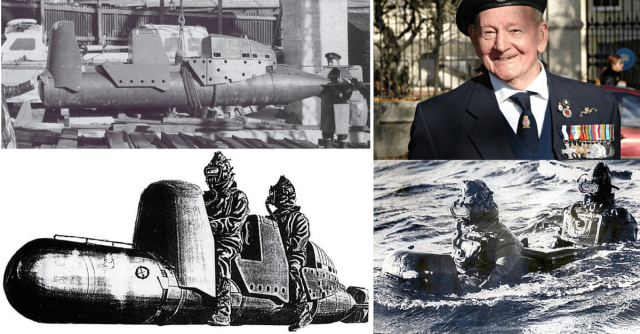A British World War Two officer who commanded a successful human torpedo mission that destroyed two Japanese warships off the coast of Thailand has died at the age of 91.
Tony ‘Lofty’ Eldridge was born in Kent in the south of England in 1923 and became a lance-corporal in the Home Guard when World War Two began. When he got to the age of 18 he enlisted and joined the Royal Navy in 1942.
Tony served on the HMS Cleveland, a Hunt-class destroyer, and in 1943 joined the HMS King Alfred where he trained to be an officer. Without knowing everything that would be involved, Tony volunteered to take part in special service. It was only when he was taken to the submarine school, and was told that he was to begin diver-training that he realized what he’d let himself in for.
It was in October 1944 that Tony, who had by then been promoted to a sub-lieutenant, along with a team of three other divers set off on Ceylon Secret Operation 51.
The team were given two human torpedoes (or chariots as they were then known). Each was around 30 feet long and 2.5 feet wide, which two crewmen would sit astride. Each chariot could travel for about six hours at a speed of around 4.5 knots, whilst carrying a more than 1000lb bomb.
Tony, the rest of his team and the two chariots were transported to the west coast of Thailand by the submarine HMS Trenchant.They launched the attack from the submarine, targeting Phuket Harbour, an island off Thai cost.
The crew had spent weeks training for the mission in Sri Lanka and were briefed on what might happen to them if they were captured by the Japanese. All of the crew were supplied with a cyanide capsule in case they needed to take their own lives if they were caught.
The crew set off on their chariots and headed to Phuket to two Japanese war ships that were moored in Phuket Harbour. It took them two and a half hours to reach the ships in the middle of the night.
They then tried to attach the warheads to the bottom of the ships. Unfortunately the ships’ hulls were covered in barnacles and the bombs would not stick with the magnets that they were fitted with. The crew had to clamp the bombs to the keel of the ships and secure them with rope. They successfully secure both bombs and set them to detonate in six hours. They got back into their chariots and headed back to the HMS Trenchant, The Telegraph reports.
The next morning around 6:30am the crew were called to the submarine’s periscope, where they saw the bombs destroy the two Japanese warships. After the war Tony helped to clear up and worked in salvage and mine-clearance. He left the Navy in 1946 and later immigrated to South Africa where he lived for the rest of his life.

